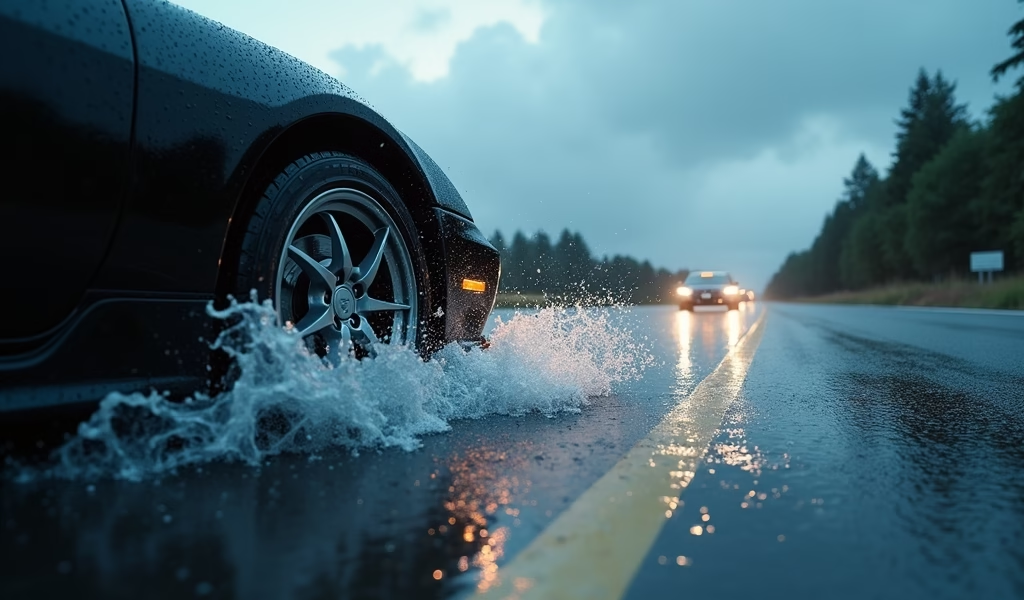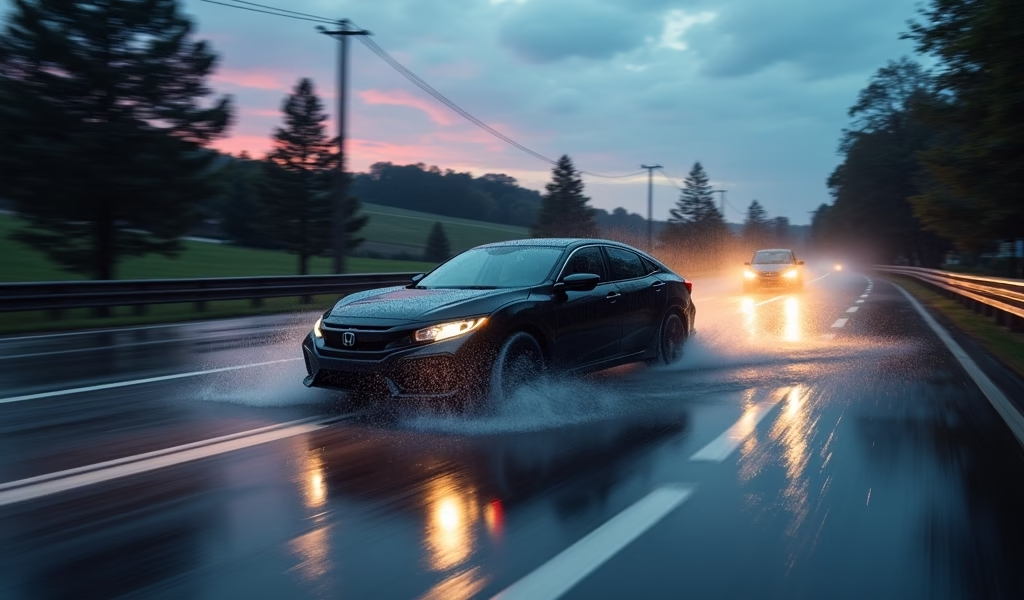Overview
This article explains the science of hydroplaning with a practical formula (square root of tire pressure × 10 = hydroplaning speed in mph) and provides seven key prevention strategies including maintaining proper tire pressure, monitoring tread depth, adjusting for vehicle weight, and slowing down in wet conditions. The author, a mechanic with 20+ years of experience, emphasizes that understanding your vehicle’s hydroplaning threshold is crucial for safety, as factors like tire design, road texture, and water depth significantly impact when your tires will lose contact with wet roads.
Table of Contents
- Understanding Hydroplaning: When Your Tires Start Swimming
- The Perfect Storm: Factors That Cause Hydroplaning
- Tip 1: The Simple Math Behind Hydroplaning Speed
- Tip 2: Your Tires’ Secret Weapon – Tread Depth
- Tip 3: Not All Wet Roads Are Created Equal
- Tip 4: Weight Matters – How Your Vehicle’s Heft Affects Hydroplaning
- Tip 5: The Science of Tire Design
- Tip 6: Bringing Numbers to Life – Real-World Applications
- Tip 7: Beyond the Math – Practical Prevention Strategies
- Staying Grounded When Roads Get Wet
- Frequently Asked Questions
Understanding Hydroplaning: When Your Tires Start Swimming
Ever had that stomach-dropping moment when your car seems to float across a rain-soaked road? One second you’re in control, the next you’re essentially piloting a 3,000-pound sled with no steering. That’s hydroplaning – when your tires lose contact with the road and skate across a film of water instead.
I’ve been fixing cars for over 20 years, and I can tell you that hydroplaning scares even the most experienced drivers. It happens in a heartbeat: water builds up faster than your tires can push it away, and suddenly you’re surfing instead of driving. Not exactly the water sport most of us signed up for!
Understanding hydroplaning speed calculation isn’t just mechanic talk – it’s practical knowledge that could save your life when the skies open up. In this guide, I’ll walk you through seven actionable tips that explain how to calculate when hydroplaning becomes a risk and, more importantly, how to avoid it altogether.
The Perfect Storm: Factors That Cause Hydroplaning
Hydroplaning isn’t random bad luck – it’s physics in action. Think of your tire like a squeegee that’s constantly pushing water out of the way. When it can’t clear water fast enough, you’ve got trouble.
Several key factors create the perfect storm for hydroplaning:
- Speed – The faster you go, the less time your tires have to channel water away
- Water depth – Even a quarter-inch can be enough to cause problems
- Tire tread condition – Worn treads can’t evacuate water efficiently
- Tire pressure – Underinflated tires create a less effective shape for water displacement
- Road texture – Smooth roads hold more water than rough surfaces
Each of these factors plays a role in the hydroplaning equation. Unlike that algebra you learned in high school, this is math that might actually save your life on a rainy day.

Tip 1: The Simple Math Behind Hydroplaning Speed
Let’s cut to the chase with the fundamental formula for estimating when your vehicle might start hydroplaning:
Hydroplaning speed (mph) = Square root of tire pressure (psi) × 10
I know, I know – you didn’t expect a math lesson from your friendly neighborhood mechanic! But this simple equation gives you a rough starting point for understanding risk.
Let’s put some real numbers to work:
- Tires at 32 psi: √32 × 10 = 5.7 × 10 = approximately 57 mph
- Tires at 36 psi: √36 × 10 = 6 × 10 = 60 mph
- Underinflated tires at 26 psi: √26 × 10 = 5.1 × 10 = approximately 51 mph
Notice how even a small drop in tire pressure significantly lowers the speed at which hydroplaning becomes likely? That’s why I’m always harping on my customers to maintain proper tire pressure – it’s not just about gas mileage and tire wear.
This formula was developed by NASA researchers studying aircraft tire performance, and while it’s not perfect for all vehicles and conditions, it gives you a solid baseline to work from. Just remember – this is your “danger zone” speed, not your “safe” speed. In heavy rain, you’ll want to stay well below this threshold.
Tip 2: Your Tires’ Secret Weapon – Tread Depth
Your tire treads are engineering marvels – those grooves aren’t there just to make cool patterns in the mud. They’re sophisticated channels designed to evacuate water from beneath your tire, and they’re your first line of defense against hydroplaning.
New tires typically have about 10/32″ to 12/32″ of tread depth. The legal minimum in most states is 2/32″, but that’s like trying to bail out a sinking boat with a teaspoon. For wet weather driving, you want at least 4/32″ of tread depth.
Here’s how tread depth affects your hydroplaning threshold:
- New tires (7/32″ or deeper): Use standard formula
- Moderately worn (4/32″ to 6/32″): Reduce calculated speed by 10%
- Significantly worn (2/32″ to 3/32″): Reduce calculated speed by 20-30%
So if your calculation showed a hydroplaning threshold of 60 mph with new tires, that same car with worn tires might start hydroplaning at just 42-48 mph. That’s the difference between a safe highway cruise and a white-knuckle slip-and-slide.
Don’t know your tread depth? Try the penny test – insert a penny with Lincoln’s head upside down into your tire groove. If you can see all of Lincoln’s head, your treads are worn below 2/32″ and you need new tires immediately. If the top of his head disappears into the tread, you’re good to go.
Tip 3: Not All Wet Roads Are Created Equal
In my years working as a mechanic, I’ve heard plenty of customers say, “But I was only going 45 in the rain!” after a hydroplaning incident. What many don’t realize is that a light drizzle on rough pavement is a world apart from standing water on smooth asphalt.
Water depth dramatically changes your hydroplaning risk:
- Light rain (water film less than 1/10″): Minimal additional risk
- Moderate rain with visible water accumulation (1/10″ to 1/4″): Reduce calculated hydroplaning speed by 10-15%
- Standing water or puddles (over 1/4″): Reduce calculated speed by 25-50%
Road texture plays a huge role too. Those grooves you see cut into some concrete highways? They’re specifically designed to channel water away and reduce hydroplaning risk. Meanwhile, that smooth, worn-out country road might as well be a Slip ‘N Slide during a downpour.
Here’s how road surfaces affect your calculations:
- Grooved concrete: Add 5-10 mph to calculated threshold
- Standard asphalt in good condition: Use standard calculation
- Worn, smooth pavement: Subtract 5-10 mph from threshold
- Roads with visible ruts or “pooling” areas: Subtract 10-15 mph
Remember, that puddle up ahead might be hiding a pothole that’s much deeper than it appears. When in doubt, slow down even more than your calculations suggest, especially in areas where water tends to collect.

Tip 4: Weight Matters – How Your Vehicle’s Heft Affects Hydroplaning
Ever notice how big rigs rarely seem bothered by rain that has your sedan white-knuckling? There’s science behind that. Vehicle weight literally presses your tires into the road, helping maintain that crucial contact patch even when water is present.
The tire contact patch pressure increases with vehicle weight, which can help squeeze out water from beneath the tire. It’s why an empty pickup truck might hydroplane more easily than when it’s hauling a load.
Consider these adjustments to your calculations based on vehicle weight:
- Lightweight vehicles (under 3,000 lbs): Reduce calculated hydroplaning speed by 5-10%
- Medium-weight vehicles (3,000-4,500 lbs): Use standard calculations
- Heavy vehicles (over 4,500 lbs): May increase hydroplaning threshold by 5-10%
Weight distribution matters too. Front-wheel-drive vehicles typically handle wet conditions better because their engine weight sits directly over the driving wheels. Rear-wheel-drive vehicles often hydroplane more easily at the front wheels because there’s less weight pressing them down.
One common mistake I see: overloading one part of your vehicle. That college move with all the heavy boxes in the trunk? You’re actually making your front wheels more prone to hydroplaning by lifting weight off them. Try to maintain proper weight distribution whenever possible, especially in wet conditions.
Tip 5: The Science of Tire Design
Not all tires are created equal when it comes to wet weather performance. Those race-inspired performance tires that grip like glue on dry pavement? They might be downright dangerous in a downpour.
Tire width plays a significant role in hydroplaning resistance. Contrary to what you might think, wider isn’t better in the rain. A wider tire has to displace more water across its larger footprint, increasing hydroplaning risk.
Here’s how different tire types affect your hydroplaning threshold:
- Narrow tires (less than 205mm width): May increase threshold by 5%
- Wide tires (over 245mm width): May decrease threshold by 5-10%
- All-season tires: Standard calculation applies
- Summer performance tires: Often worse in heavy rain; reduce threshold by 5-10%
- Winter tires: Generally better in rain due to aggressive siping; add 5% to threshold
- “Rain” or wet-weather performance tires: May add 10-15% to threshold
The tread pattern makes a huge difference too. Those zigzagging grooves, called sipes, help create edges that bite into wet surfaces. Meanwhile, the larger channels evacuate water from under the tire. It’s like the difference between trying to move water with a broom versus a squeegee.
If you live in a rainy climate, it’s worth investing in tires specifically designed for wet-weather performance. As independent testing has shown, the difference between the best and worst tires in wet conditions can be the equivalent of driving 15-20 mph slower.
Tip 6: Bringing Numbers to Life – Real-World Applications
All these calculations are helpful, but how do you actually use them when you’re behind the wheel and the sky opens up?
First, do your homework before the storm. Calculate your vehicle’s approximate hydroplaning threshold based on your tire pressure, tread depth, and vehicle weight. Then set your personal “rain speed limit” at least 10-15 mph below this number.
But don’t just set it and forget it! Conditions change constantly during a rainstorm. What starts as a light drizzle can quickly become a downpour, and that straight, well-drained highway might lead to a dipped section where water pools.
Watch for these warning signs that hydroplaning risk is increasing:
- Increased spray from vehicles ahead of you
- The sound of your tires on wet pavement changing from a steady hum to a softer, “slushy” sound
- A slight feeling of “lightness” in your steering
- Water pooling or running across the road
- Ruts in the pavement filling with water
Remember that every vehicle behaves differently in wet conditions. That SUV passing you might have better tires or different weight distribution. Don’t let others set your speed – trust your calculations and your vehicle’s unique characteristics.
I tell my customers to think of it like cooking: the formula gives you a recipe, but you still need to taste and adjust as you go. Your senses and experience are just as important as the numbers.
Tip 7: Beyond the Math – Practical Prevention Strategies
Numbers and formulas are great, but preventing hydroplaning requires action. Here are my top recommendations after decades of seeing the aftermath of wet-weather accidents:
- Maintain proper tire pressure – check monthly and before long trips
- Replace tires before they reach 3/32″ tread depth if you regularly drive in rain
- Slow down before hitting visible water, not as you’re entering it
- Follow in the tire tracks of vehicles ahead when possible (they’ve already displaced some water)
- Increase following distance to 3-4 times normal in wet conditions
- Avoid cruise control on wet roads – you need to be able to immediately adjust power
- Keep both hands on the wheel when driving through potential hydroplaning conditions
Modern vehicles come with technology designed to help prevent or manage hydroplaning. Anti-lock Braking Systems (ABS), Electronic Stability Control (ESC), and traction control can all help you maintain or regain control in slippery conditions. But remember – these systems can’t defy physics. They help manage traction loss, not prevent it entirely.
If you do feel your vehicle beginning to hydroplane, don’t panic! Ease off the accelerator (don’t brake), keep the steering wheel straight, and wait for your tires to regain contact with the road. Sudden movements are your enemy here – smooth and steady wins the race.
Staying Grounded When Roads Get Wet
Hydroplaning is one of those driving hazards that can turn a routine trip into a terrifying experience in seconds. But armed with the knowledge of how to calculate your risk threshold and the practical steps to stay below it, you’ve got science on your side when the rain starts falling.
Remember that all these calculations provide estimates, not guarantees. The safest approach is to stay well below your calculated threshold and adjust continually as conditions change. Think of your hydroplaning threshold as the edge of a cliff – knowing exactly where it is doesn’t mean you should walk right up to it.
Before your next rainy drive, take a few minutes to check your tire pressure, inspect your tread depth, and calculate your vehicle’s approximate hydroplaning threshold. It might be the most important math you’ll ever do.
The roads will always get wet, but with these seven tips, you can dramatically reduce your risk of hydroplaning. Because at the end of the day, the most important cargo your vehicle carries isn’t in the trunk – it’s sitting behind the steering wheel.
Frequently Asked Questions
What is the most accurate formula for calculating hydroplaning speed?
The square root of tire pressure (psi) multiplied by 10 gives you a good baseline in mph. This NASA-derived formula is most accurate for standard passenger vehicles with all-season tires.
Does ABS prevent hydroplaning?
No, ABS doesn’t prevent hydroplaning but helps maintain control after it occurs. It prevents wheel lock-up during braking, allowing you to maintain some steering control.
Are wider tires better for preventing hydroplaning?
Actually, wider tires are generally worse in wet conditions. They must displace more water across their larger contact patch, increasing hydroplaning risk.
At what speed does hydroplaning typically occur?
Most passenger vehicles with properly inflated, good-condition tires begin hydroplaning around 50-60 mph in 1/10″ of water. This threshold drops significantly with worn tires, lower pressure, or deeper water.
What should I do if my car starts hydroplaning?
Ease off the accelerator (don’t brake), keep the steering wheel straight, and wait for tires to regain traction. Avoid sudden movements or corrections until you feel the tires reconnect with the road surface.

